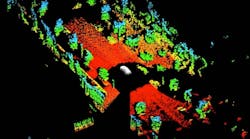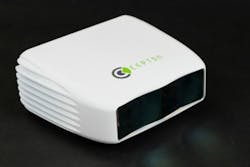The automobiles we drive today are loaded with onboard sensors to provide drivers with information such as tire pressure and navigation guidance as well as advanced safety features including lane departure warning and automatic emergency braking.
The next evolution may well be the addition of automotive LiDAR to complement and extend the range, accuracy, and resolution of existing onboard sensors. This would provide a more complete 3D image of objects around the car and enable automotive manufacturers to deliver more advanced safety features such as collision avoidance, night vision, enhanced adaptive cruise control, and semi-autonomous driving modes.
Cepton Technologies’ newest Vista LiDAR sensor, the Vista-X120 (see figure), specifically targets advanced driver-assistance systems (ADAS) and autonomous applications. It offers a 120-degree horizontal field of view (FOV), 0.15-degree angular resolution, and a maximum detection range of up to 200 meters at 10% reflectivity.
The Vista-X120 offers a 120-degree horizontal field of view (FOV), 0.15-degree angular resolution, and a maximum detection range of up to 200 meters at 10% reflectivity.
Powered by Cepton’s Micro Motion Technology (MMT), Vista-X120 builds on the existing Vista-P60 product currently shipping to customers worldwide. Cepton hasn’t shared many technical details of how MMT works except to say that its LiDAR array moves, but not with mirrors (avoiding the inevitable light loss) and not with motors. A frictionless beamsteering architecture is said to eliminate mechanical wear as well as make Vista-X120 rugged and durable.
The Vista X120 doubles the FOV compared to the standard Vista sensor enabling object perception and localization, in a much wider area. According to the company, by leveraging a common core technology optimized for power and cost, the Vista-X120 enables high-volume price points in the hundreds of dollars for mass-market automotive applications.
Modular LiDAR
Cepton’s Vista LiDAR sensors are designed in a small form factor that operates on only 9 W of power, enabling automotive designers to aesthetically integrate LiDAR sensors into their vehicle body and electrical systems. Indeed, in February, the company filed a patent application for incorporating LiDAR sensors into a headlamp module of a vehicle.
According to the patent summary, the LiDAR submodule would be placed near the headlamp illumination module so that light could be transmitted through the same window of the headlamp housing. The LiDAR sensor would include one or more laser sources configured to emit laser beams transmitted through the window toward the scene in front of the vehicle, with the laser beams being reflected off of one or more objects in the scene. Return beams are then generated through the window toward the LiDAR sensor and one or more detectors configured to receive and detect the returning laser beams.
The 200-meter range of the Vista X-120 allows on board software to detect objects, then react and decide on the next course of action for a vehicle traveling at speeds of 65 mph. If you want object classification, you need to know that you’re seeing what the object is, at close range or long range. The Vista X-120’s 0.15-degree angular resolution allows it to sense small obstacles in the road with a high level of accuracy.
Vista-X120 can be combined with Cepton’s Helius LiDAR perception software, enhancing its object detection and perception capabilities for autonomous applications. Helius utilizes the accuracy of lasers combined with AI-driven detection and tracking technologies to build a detailed image of activity in a given area, regardless of lighting conditions.
“With its robust construction, its high resolution, wide field of view, and long range, the Vista-X120 is the next logical step in the evolution of Cepton’s roadmap and introduces an exciting, power-efficient LiDAR that is ideal for mass-market ADAS and autonomous applications,” says Dr. Jun Pei, CEO of Cepton.


